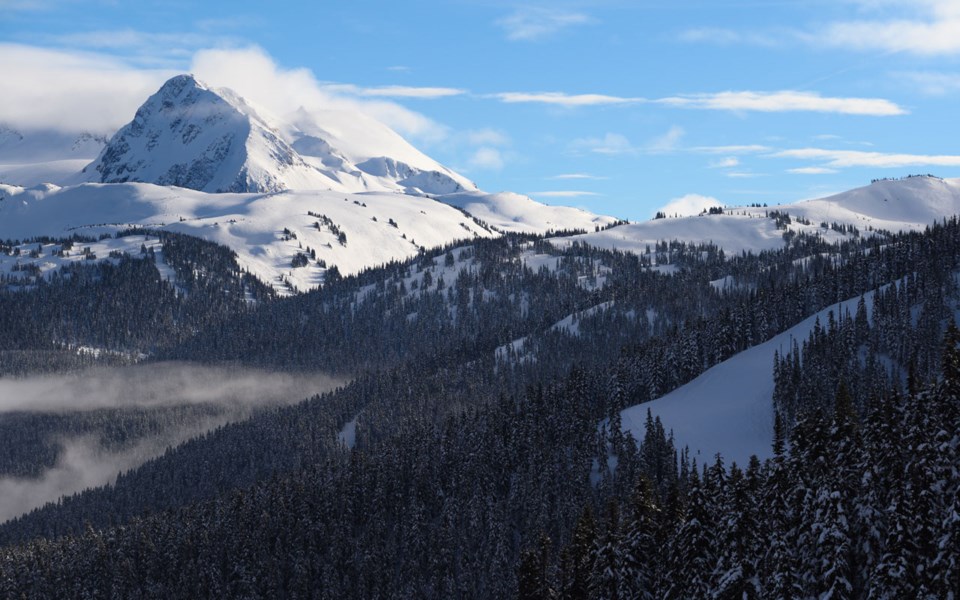A joint Whistler and North Shore mission last week was not only a happy ending for two ski tourers stranded on Fissile Mountain, it also marked a first for search-and-rescue in B.C.
“We certainly do lots of mutual aid calls and we do them at night, but this heralded the first time in the history of British Columbia that two teams came together to do a night helicopter rescue,” said Whistler Search and Rescue (WSAR) manager Brad Sills of the joint callout with North Shore Rescue.
Ideal weather conditions combined with the use of a North Shore Rescue’s (NSR) newly acquired night-vision imaging system to facilitate the helicopter mission. In December, NSR became the first volunteer search-and-rescue group in the country to get the greenlight to pilot the technology after the night-vision goggles were previously restricted to official organizations such as the police and military. The organization currently has seven pairs of the goggles, and its partner, Talon Helicopters, has purchased an aircraft equipped with night-vision capability.
“It’s really new,” Sills said, adding that WSAR will be trained on the technology soon. “It took North Shore about 18 months to get approval for the pilot project and it was supported by all the SAR teams in the Lower Mainland.”
The mission got underway last Wednesday evening, March 10 after Whistler crews were alerted to an apparent Size 3 avalanche that had trapped the two skiers on the fragile, bed surface of the slide, according to an incident report. There was initially concern that the 30-centimetre snowpack “would continue to step down around the pair on the very steep, exposed southwest slope,” the report went on.
Adding to the concern was the party’s apparent lack of preparedness to spend the night in the elements. Although Sills said the pair had an extra down jacket, they brought a summer sleeping bag and did not pack a rope that could have enabled a self-rescue in the steep terrain.
“‘I find the practice of ski tourers that are on the Spearhead Traverse without a rope to be extremely troubling. There are just so many instances where you could self-extricate with it, and because you don’t, you necessitate somebody else coming to your aid,” he said.
After consulting with WSAR avalanche technicians, the skiers “eventually inched their way back up onto the established route and relative safety,” WSAR said in its report.
With a plan to fly at first light to extricate the pair, the skiers were coached to dig a snow cave and bundle up to spend the night out. However, at 9:20 p.m., the skiers texted volunteer crews to say they were in the process of building a shelter but were experiencing cold chills and requested rescue.
Sills also noted the Spearhead Huts Society’s Kees and Claire Hut—which, although closed in the pandemic, has a rescue vestibule where parties can take shelter—was just a few kilometres away from the scene, but SAR personnel chose not to direct the pair there as they were “just happy to get them off of the face, onto the ridge.”
Faced with -12-degree-Celsius temperatures and 20-kilometre-an-hour winds, “SAR managers had to make a difficult decision,” WSAR went on. “The risks of balancing a ground rescue effort and placing the rescue party on the same slopes against the current safety and situation of the subjects was a resolution that needed to be weighed very carefully.”
After connecting with NSR and Talon Helicopters, a plan was formulated to send a helicopter to the scene in order to lower overnight kits to the stranded party. However, an assessment determined a helicopter landing was possible nearby, so the decision was made to rescue the skiers and transport them to Whistler’s Municipal Heliport. The operation ended successfully around 12:30 a.m.
“Whistler SAR would like to thank NSR for their careful consideration in this matter,” WSAR said in its incident report. “This type of rescue is not unlike other SAR operations in which there exists an inherent element of risk. The volunteer SAR community will continue to explore and develop tools that seek to mitigate these risks and that is the lens through which [night-vision imaging system] rescue should be viewed. Recreationalists should not be interpreting this as a solution to poor planning. The conditions for this type of operation were almost perfect and clear starry nights are not a common commodity in the Coast Mountains.”



